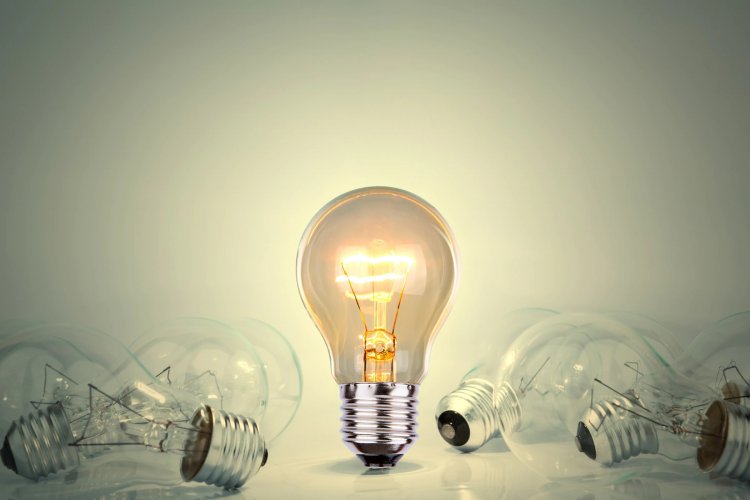Had Thomas Edison lived in our time, he would have been surprised by the number of light bulbs that have appeared in our world, and he certainly would not have ended up with only one patent. Read more about the history of the light bulb, its design, and its modern types in our article.
How Artificial Light Works
Have you ever wondered how a light bulb or, more specifically, an incandescent light bulb is constructed? It seems impossible to think of anything more ordinary, and yet a lot of inventors have been working on its creation for many years. An incandescent light bulb is an artificial source of light. The incandescent body is heated by the electric current to a high temperature. In order for the human eye to see the radiation coming from the heated element, it must be heated to over 570 degrees. This is the point of red light that can be perceived by the human eye in the dark. The most commonly used filament is a tungsten spiral (a special refractory material) or a carbon rod. It is important to keep the filament out of contact with the air, otherwise the filament will oxidize. This is why the filament body is placed in a special bulb. It doesn't sound difficult, but the inventors had to go a long way to understand it by trial and error.
Who Invented Incandescent Light Bulb
Just like it happens with the majority of popular and necessary inventions of everyday life, we cannot limit the answer to this question to only one person. Of course, we immediately think of Thomas Edison, who patented a number of inventions in his lifetime. The most famous of them are the phonograph, the kinetoscope, and the incandescent light bulb itself. However, the idea of the light bulb had already existed before him and was being explored at a very rapid pace.
In 1840, an English scientist, De la Rue, runs an electric current through a platinum wire placed in a glass cylinder. That same year, a Russian scientist, Alexander Milashenko, begins to develop carbon rod.
A year later, an Irish scientist, Frederick de Moleyns, patents the generation of electricity using platinum filament in a vacuum to produce light and motion. In 1844, a patent for an electric lamp with a carbon rod appears in America.
In 1854, a German scientist, Heinrich Göbel, decides to use a bamboo filament as the filament body and create a vacuum using mercury. Such a light bulb could last for several hours.
Finally, in 1874 Alexander Nikolayevich Lodygin's filament lamp appears; it could work much longer than its predecessors due to the carbon rod hermetically sealed in the glass enclosure. This made it possible to use the lamps outside of the laboratory. The luminescence time of such a bulb was increased by V. F. Didrihson, who added a few more “hairs” to the filament. When one “burned out,” the next one “lighted up.”
In the mid-70's, a Russian technician, Pavel Nikolayevich Yablochkov, finds out that kaolin is a good electrical conductor when exposed to high temperature. After that, in order not to be unsubstantiated, he creates a kaolin lamp. The filament in such a lamp did not burn out in the open air. However, the inventor's sphere of interest quickly moved on to the arc lamps.
In 1878, an English scientist, Joseph Wilson Swan, receives a patent for a lamp with a carbon rod. The rarefied oxygen atmosphere that surrounded the rod increased the light brightness. A year later, Thomas Edison patents the lamp with a carbon rod again, but transforms it significantly. Its burning time increases to 40 hours. The whole idea was to choose the right material for the rod. After numerous experiments and tests, Edison introduced the light bulb into human daily life. In addition to the right material and the right design, he fine-tuned the artificial light source with a switch and unified the bases.
You might think, what could be better than that? However, other researchers continued to improve the invention. Alexander Nikolayevich Lodygin became a new hero in the world of electric illumination. He created tungsten and molybdenum filaments and then twisted them into a spiral shape.
After that, the inventors continued to experiment, primarily with the filament material. They used such materials as magnesium oxide, thorium, zirconium, yttrium, metallic osmium, and tantalum. However, in this case, tungsten proved to be the best. In 1906, Lodygin sells his patent to General Electric. Tungsten takes the lead, and, after Irving Langmuir came up with the idea of filling the bulb with a heavy noble gas called Argon, the problem of the short life of electric light was solved. Tungsten filaments outperformed all their competitors.
So Many Kinds of Light Bulbs
Today, if we go to a store, we will see a lot of different lamps:
-
classic incandescent lamps,
-
fluorescent lamps,
-
halogen lamps,
-
LED lamps,
-
energy saving lamps,
-
infrared lamps,
-
neon lamps,
-
sodium vapor lamps,
-
xenon arc lamps,
-
quartz lamps,
-
ultraviolet lamps…
And it is not a complete list. Let us tell you more about some of them.
The fluorescent lamp, or the daylight lamp, is a “descendant” of the first gas discharge lamp. The principle of its operation was discovered by Mikhail Vasilyevich Lomonosov when he ran a current through a glass ball filled with hydrogen and saw that the gas could emit light. In 1891, Nikola Tesla patented the electric lighting with gas discharge lamps. They were based on argon gas, and luminescence itself was actually a non-thermal glow that occurs after a substance absorbs energy. The luminous efficiency of such a lamp was many times higher than that of a conventional incandescent lamp at the same wattage. Such models became popular for illuminating large workrooms, as they were brighter and more enduring than conventional light bulbs.
The LED lamps are a source of light powered by light-emitting diodes, semiconductors that generate visible optical radiation when electricity flows through them. Today we know them as LED – elements that are used in the creation of modern technology and electronics. In 1907, physicist Henry Round saw colorful radiation when electricity flowed through a silicon-metal carbide compound. This process became known as electroluminescence. Then Oleg Losev found out that this phenomenon is observed exclusively at the contact surface of heterogeneous metals. The first LED source of visible light was developed at General Electric in 1962. Its creator, Nick Holonyak, was nicknamed the “father of LEDs.” The first samples were weak and could only reflect dark red colors. It was a little gloomy and ineffective for general lighting. Over time, the invention was improved and eventually evolved into the LED lights and certain types of lamps.
The infrared lamp is used as a source of heat, not light. The principle of infrared radiation is similar to that of solar radiation. The rays reach the surface of objects and warm them up. The ambient air is not heated up, since it is a good insulator. Infrared halogen lamps can protect you from the cold outside, even when other heating systems are useless. Infrared radiation is also used in medicine.
The ultraviolet lamp emits light that cannot be seen by the human eye. Basically, it is a fluorescent lamp with a special luminescent material that emits ultraviolet rays. It happens due to the interaction of electrodes and mercury vapor. That is why such bulbs are not thrown in the trash, they are disposed of in a special way. Such lamps are used in medicine, for baiting insects, disinfecting water, stimulating plant growth (phytolamps). They are even used by restorers to see the hidden parts of the picture, and criminologists to see invisible evidence (traces of blood and fingerprints). The tanning salons also have ultraviolet lamps, and the gel polish on the nails can only become dry under ultraviolet exposure. It is interesting that reptiles also need ultraviolet light. They are cold-blooded animals and this type of radiation is vital for them.
The energy saving lamp is an electric lamp that has a higher light output in comparison with a traditional incandescent lamp. It can be fluorescent or LED lamps of various designs. The main distinguishing feature of the energy saving lamp is the color temperature: 2700 K — soft white, 4200 K — daylight, 6400 K — cool white. Measurements are counted in degrees on the Kelvin scale. The lower this figure is, the closer the color is to red; the higher it is, the closer the color is to blue. Everyone can choose the shade they like best.
The article is based on open sources.
Фото на странице и на главной странице сайта: jannoon028 / Фотобанк Freepik






















